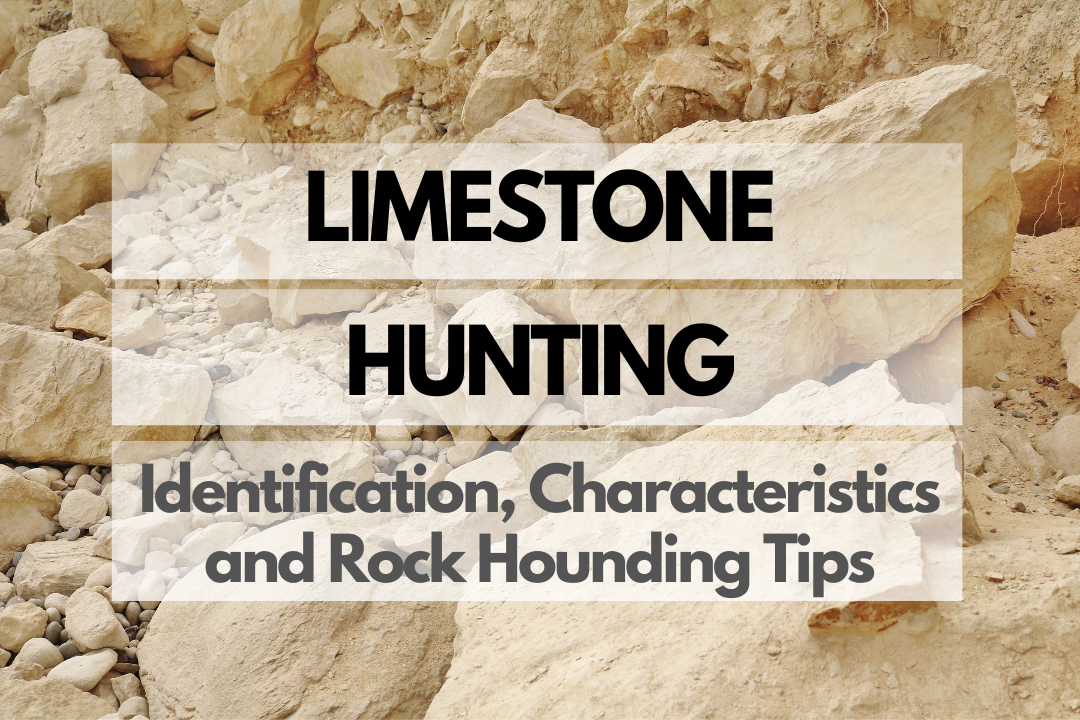Unleash your inner geologist and explore the fascinating world of limestone! This versatile sedimentary rock offers a glimpse into Earth’s history, showcases a variety of unique characteristics, and provides endless opportunities for discovery. Join us as we delve into the allure of limestone and share some rock hounding tips to help you on your next adventure.
History & Origin of Limestone
Limestone is an ancient rock formed millions of years ago from the skeletal remains of marine organisms, such as corals, mollusks, and foraminifera, which settled on the ocean floor. Its name is derived from the Latin word ‘limes,’ meaning ‘stone,’ and ‘calx,’ which means ‘lime’ – a reference to one of its primary components, calcium carbonate. Across different cultures, limestone has been used for various purposes, such as constructing monuments, temples, and even the iconic Egyptian pyramids.
Limestone Identification & Physical Properties
Identifying limestone can be an enjoyable challenge for rock enthusiasts. Here’s an overview of the rock’s physical properties to help you with identification:
| Property | Characteristics |
|---|---|
| Mineral Composition | Primarily calcium carbonate (CaCO3), with minor amounts of other minerals |
| Grain Size | Very fine to coarse-grained |
| Texture | Clastic, crystalline, or microcrystalline |
| Hardness | 3 to 4 on the Mohs scale |
| Specific Gravity | 2.7 to 2.9 |
| Acid Reaction | Effervesces in contact with dilute hydrochloric acid (HCl) |
Limestone Colors
Limestone exhibits a range of colors, including white, gray, pink, yellow, and even black. These colors result from the presence of different minerals and impurities, such as iron oxide or clay.
Limestone Hardness
Limestone is a relatively soft rock, ranking between 3 and 4 on the Mohs scale of mineral hardness. This characteristic makes it easy to work with and shape for various applications.
Limestone Types
There are several types of limestone, each with its unique characteristics:
Chalk
Chalk is a soft, white limestone composed of the microscopic remains of marine plankton. It is known for its porous texture and is commonly used in writing and drawing materials, such as chalkboard chalk.
Coquina
Coquina is a coarse-grained limestone made up of loosely-cemented shell fragments. It is often used as a building material and can be found in many coastal regions around the world.
Travertine
Travertine is a form of limestone deposited by mineral springs, such as hot springs. It has a fibrous or banded appearance and is often used for decorative purposes, such as flooring, countertops, and wall cladding.
Lithographic Limestone
Lithographic limestone is a fine-grained, dense limestone with a smooth, even surface. Its unique properties made it ideal for use in lithography, a printing process developed in the late 18th century.
Limestone Uses
Limestone has a variety of uses, including:
- Building material for homes, offices, and historical monuments
- Landscaping and gardening projects, such as patios, garden stones, and retaining walls
- Agricultural applications, such as soil amendment and animal feed supplements
- Industrial uses, including cement production, glass manufacturing, and water treatment
- Decorative purposes, such as flooring, countertops, and wall cladding
How Much Is Limestone Worth?
The value of limestone varies depending on factors such as its type, quality, and intended use. Generally, prices can range from a few dollars per square foot for basic limestone slabs to several hundred dollars per ton for more specialized or high-quality materials. Keep in mind that the cost of limestone may also be influenced by factors like transportation, processing, and regional availability.
Limestone Rock Hounding Tips
Ready to embark on your limestone rock hounding adventure? Here are some tips and tricks to help ensure a successful and enjoyable hunt.
Essential Tools and Equipment
Before you head out, make sure you have the right tools and equipment to make your limestone hunt a breeze:
- Rock hammer: A must-have for breaking open rocks or chipping away at limestone deposits.
- Chisel: Useful for splitting rocks and carving specimens.
- Hand lens or magnifying glass: Helps with close inspection and identification of limestone samples.
- Field guide: A reference book with information on limestone identification, properties, and locations.
- Backpack or collection bag: To store and transport your limestone finds.
- Sturdy footwear, gloves, and protective eyewear: For safety and comfort during your hunt.
Safety Tips
Rock hounding should be a fun and safe experience. Keep these safety tips in mind:
- Always wear appropriate safety gear, such as gloves, sturdy footwear, and protective eyewear.
- Be aware of your surroundings and watch out for hazards, like loose rocks, steep slopes, or slippery surfaces.
- Take a buddy along for your adventure, and let someone know your plans and estimated return time.
- Stay hydrated and take breaks as needed, especially during hot or strenuous hunts.
- Follow all posted rules and guidelines in the areas you are visiting.
Limestone Hunting: Where to Find Limestone
Limestone can be found in many parts of the world, particularly in areas with a history of marine sedimentation. Some of the best places to find limestone include quarries, road cuts, and coastal cliffs. Here’s a table detailing specific locations where you can find limestone:
| Site/Area | City/State/Country |
|---|---|
| Cliffs of Dover | Dover, England, UK |
| Indiana Limestone Belt | Indiana, USA |
| Great Barrier Reef | Queensland, Australia |
| Blue Hole of Belize | Belize, Central America |
| Carlsbad Caverns | New Mexico, USA |
Caring For Your Limestone
Once you’ve found your prized limestone specimens, proper care is essential to maintain their beauty and value. Here are some tips:
- Store limestone in a cool, dry place to prevent damage from moisture or temperature fluctuations.
- Use a soft brush to clean dirt and debris from your specimens. Avoid using harsh chemicals or abrasive materials, as they may damage the rock’s surface.
- Display your limestone collection out of direct sunlight, as prolonged UV exposure can cause fading or discoloration.
Additional Resources
For more information on limestone and rock hounding, check out these helpful resources:
- U.S. Geological Survey: https://www.usgs.gov/
- Mindat.org: https://www.mindat.org/
- Rockhoundlounge.com: http://www.rockhoundlounge.com/
- Books: “Rocks & Minerals of North America” by Charles A. Sorrell
Additional Limestone FAQs
What are the benefits of Limestone?
Limestone offers numerous practical benefits, such as its use as a building material, agricultural applications, and industrial uses. Its unique appearance and variety also make it a popular decorative material for flooring, countertops, and wall cladding.
Do Limestone have any healing properties?
Although there is no scientific evidence to supportthe idea of healing properties in limestone, some people believe that the rock can help with grounding, stability, and emotional balance due to its connection to the earth.
Do Limestone have any spiritual meaning?
In various cultures, limestone has been associated with different spiritual meanings. For example, in ancient Egypt, limestone was believed to have protective properties, and it was commonly used in the construction of temples and pyramids.
Do I need a permit to go Limestone hunting?
Permit requirements for limestone hunting vary by location. In some areas, you may need a permit or permission to collect specimens on public or private land. It’s essential to research the rules and regulations in the area where you plan to go rock hounding. For more information on permits in the United States, visit the Bureau of Land Management (BLM) website: https://www.blm.gov/
Closing Thoughts
With the right tools, knowledge, and an adventurous spirit, limestone rock hounding can be an exciting and rewarding pursuit. Remember to prioritize safety, follow local rules and regulations, and respect the environment during your hunts. So, gear up, get out there, and start uncovering the hidden treasures that limestone has to offer!

